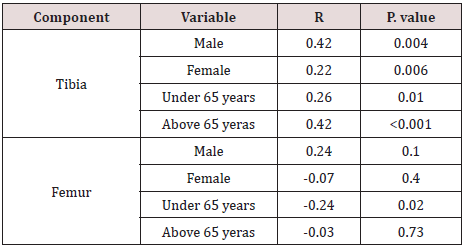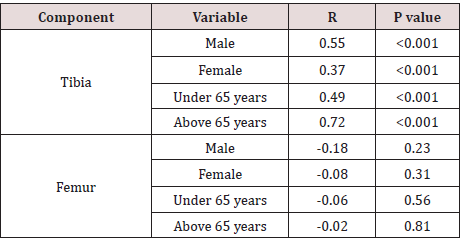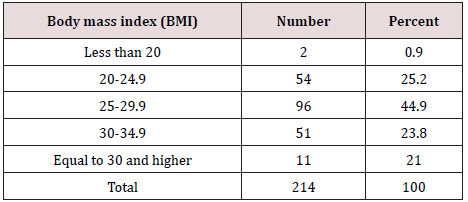
Lupine Publishers Group
Lupine Publishers
Menu
ISSN: 2644-1217
Research ArticleOpen Access
The Effect of Body Mass Index on Components Size in Patients With Total Knee Replacement Volume 3 - Issue 1
Gholamreza Ghorbani Amjad1, Sajjad Daneshyar2*,Elham Khan larzade3, Mohammad Hossein Rizehbandi1, and Alireza Noori gholami zadeh4
- 1Assistant Professor, Department of Orthopedics, School of Medicine, Hamadan University of Medical Sciences, Hamadan, Iran
- 2Student Researcher committee,Hamadan University of Medical Sciences ,Hamadan, Iran
- 3Department of Community Medicine, School of Medicine,Hamadan University of Medical Sciences, Hamadan, Iran
- 4MSc, School of Nursing and Midwifery , Hamadan University of Medical Sciences ,Hamadan, Iran
Received: February 05, 2021 Published: March 22, 2021
*Corresponding author: Sajjad Daneshyar, Student Researcher committee, Hamedan University of Medical Sciences, Hamedan, Iran
Abstract
Introduction: Nowadays, one of the most common practices in orthopedic surgery is the Total Knee Arthroplasty. Logistic equipment, including prostheses, is the cornerstone of this surgical procedure. Clearly having a general overview of the size of consumable prostheses, the surgeons will act more confidently.
Materials and Method: This descriptive-analytic study employed a census method based on the inclusion criteria of the medical records of all patients who underwent knee replacement surgery in Besat Hospital of Hamedan in 1395 (2016-17) in terms of body mass index, age, gender, and size of tibial and femoral components. Data were analyzed by SPSS software version 16.
Results: A total of 214 patients were included: 21.5% male and 78.5% female. The mean age of patients was 67.95 years, and the mean body mass index was 27.98 kg/m2. As for the assessment of the size of components, most tibial components were of medium size (49.5%) and femoral components were of small size (65.9%). It was seen that there was an inverse correlation between tibial component and body mass index (BMI), and a direct and significant correlation between tibial component and height and weight in terms age and gender (p<0.05). Nevertheless, the correlation between femoral component and weight was statistically significant only at ages under 65 years and it was indirect (p=0.02).
Conclusion: Determining factors of the size of components used in joint replacement surgery include body mass index (BMI), weight and height of the patients for tibial surgeries, and weight of the patients for femoral ones.
Keywords: Body mass index (BMI); tibial component; femoral component
Abbreviations: OA: Osteoarthritis; BMI: body mass index; TKA: Total knee arthroplasty
Introduction
Knee joint is one of the main joints of human body which is usually affected by various progressive degenerative and inflammatory diseases, which ultimately lead to the destruction of articular cartilage (arthrodial cartilage) and its dysfunction [1]. Osteoarthritis (OA)is the most common form of knee arthritis that slowly and progressively causes damage to the knee joint and is a major contributor to functional disability [2,3]. The prevalence of osteoarthritis is high among the elderly and women [4]. It is estimated that knees, with prevalence of 41%, are the most frequently affected joints by osteoarthritis among adults [5]. Obesity is the most accelerating cause of this disease. Other important predisposing factors include: old fractures that cause irregularities in articular surfaces; previous illnesses that have damaged the articular surfaces (especially the end stages of rheumatoid arthritis or septic arthritis); previous intra-articular mechanical damage, such as meniscus tear or osteo chondritis dissecan; andtibial dislocation relative to the femur (in long-lasting cases of genu varum or genuvalgum for any reason) [6]. Progression of osteoarthritis causes the destruction of cartilage, bone, and its adjacent soft tissue (ligaments, capsules, tendons, and muscles) which ultimately leads to knee deformity, ligamentous instability or instability [7].
gradually causes various deformities in knee joint and makes
it painful while walking. It also disrupts skeletal alignment and
increases the risk of Osteo arthritisfalling and fractures. The
disease usually affects both limbs and this mutuality can exacerbate
functional disorders [8]. Osteoarthritis causes major health and
social problems in the elderly and brings a heavy economic burden
on the health and social welfare system [9].
Progression of the disease in this weight-bearing joint leads
to significant disability and reduced functional capacity in a wide
range of daily activities. The main causes of this functional decline
in the patients are weakness of the quadriceps muscle, deep-seated
perturbation and poor stability [10,11,12].
Common therapies for reducing pain and improving patients’
function include lifestyle changes and daily habits, rehab
Rehabilitation and medicine therapy [13]. Patients with symptoms
of pain, joint instability, reduced range of motion and deformity, and
lack of response to conservative treatment need to have a surgery,
which may include knee joint replacement. In spite of reducing the
patients’ pain and improving the quality of their life, this surgery
is a costly process with relatively high complications. Therefore,
accurate preoperative planning for reducing costs and probable
complications is so important for these patients. The planning
procedure includes the preparation of medicine, equipment and
operating room. Logistic equipment, including prostheses, is the
cornerstone of this surgical procedure. Clearly having a general
overview of the size of consumable prostheses, the surgeons will
act more confidently. Since the results of various studies regarding
body mass index, component size and surgical complications are
controversial and sufficient studies have not been done in this
field, this study aimed to examine the effect of BMI on the size of
components used in patients undergoing knee joint replacement
surgery.
Method
This descriptive-analytic study examined all patients suffering
from severe knee joint osteoarthritis who had came to the
orthopedic clinic and after clinical examination, had undergone
arthroplasty surgery. The required data for patients’ medical
records and surgical description were extracted and recorded in the
checklist. Preoperative data, including preoperative examinations,
lateral and patellar radiographies, and lower limb alignment were
documented. Preoperative counseling was done and its information
was recorded. In the alignment graph, the angle between the
mechanical axis of femur and tibia was measured. The BMI of the
patients after recording height and weight was calculated using
SPSS software. The patients transferred to the operating room and
received anesthetic injections. Their consciuosness was assessed
and the size of tibial and femoral component used for them was
measured by the the classic anterior midline approach after incising
tibia and femur. Finally, the joint replacement was completed using
a cement prosthesis (ZIMMER, NEXGEN LPS, WARSAW, US), and
the day after surgery, patients were prepared for recovery and
discharged with appropriate equipment. The common size of
the femoral component used for patients was 8. To facilitate the
analysis, the sizes 1 to 3 were classified in the small group, the sizes
4 and 5 in the medium group and the sizes 6 to 8 in the large group.
Moreover, body mass index (BMI) was classified in very fat (35≤),
fat (34.9-30), normal (24.9-20), and thin (20>), based on the WHO
standard categorization. Then, the relationship between BMI and
size of measurements was measured using statistical analysis.
The inclusion criteria of the study were all patients with severe
knee joint osteoarthritis who were candidates for joint replacement
surgery, along with their satisfaction for participation in the study,
and exclusion criteria were the incompleteness of the data recorded
in the case, the patients’ discontent and their unwillingness to co
operatation.
Statistical analysis
The collected data were entered into computer and analyzed using SPSS version 16.0 statistical software. Quantitative data were described using mean and standard deviation; qualitative data were described in the form of tables, charts and frequency ratios. In the analytical section, Pearson correlation coefficient (PCC) was used to determine the correlation between quantitative variables and the size of tibial and femoral components; Spearman’s correlation coefficient was used to determine the correlation between ranked variables and the size of tibial and femoral components. The significance level in this study was considered as 0.05.
Results
Descriptive data of the 214 patients examined in the study are as follows
In terms of gender, the highest frequency belongs to the female group of 168 (78.5%) and the frequency of male group is 46 (21.5%). In terms of age, mean age of the participants of this study was 67.95 years. The minimum age was 32 years and maximum age was 94 years. The most frequent ages among patients undergoing knee joint replacement surgery was 60 to 69 years (46.26%). As for BMI of the patients undergoing knee joint replacement surgery, the mean body mass index was 27.89 kg/m2 (range 17.58-44 kg/ m2; standard deviation 4.49 kg/m2). The highest frequency was in the overweight group (25-29.9) (Table 1).
In terms of component size frequency, most tibial components
were of medium size (49.5%) and most femoral components were
of small size (65.9%). For used tibial components (small-mediumlarge)
classified by various categories of BMI, no statistically
significant rank correlation was observed between the size of used
tibial component and BMI (P=0.097).
According to the results of one way ANOVA test, a statistically
significant difference was observed between the mean BMI and
the size of used tibial component (P=0.005). The results of Tukey
follow-up test showed that the mean BMI in small component
(P=0.006) and in medium component (P=0.013) were significantly
more than the mean BMI in large component (Table2).
For used femoral components (small-medium-large) classified by various categories of BMI, no statistically significant rank correlation was observed between the size of used femoral component and BMI (P=0.570) (Table3).
According to the results of one way ANOVA test, no statistically
significant difference was observed between the mean BMI and the
size of femoral component (P=0.156).
As for the relation between the size of tibial and femoral
component and weight in terms of gender and age, a direct and
significant was observed between tibial component and weight
in terms age and gender (p<0.05). Nevertheless, the correlation
between femoral component and weight was statistically significant
only at ages under 65 years (p=0.02) (Table 4).
Table 4: Correlation coefficient of the relationship between the size of tibial and femoral component and weight in terms of age and gender.

Moreover, for the relation between the size of tibial and femoral component and height in terms of gender and age, a direct and significant was observed between tibial component and heightin terms age and gender (p<0.05). Nevertheless, the correlation between femoral component and height was not statistically significant (p<0.05) (Table 5).
Table 5: Correlation coefficient of the relationship between the size of tibial and femoral component and height in terms of age and gender.

Discussion
Knee joint is one of the main joints of human body which
is usually affected by various progressive degenerative and
inflammatory diseases, which ultimately lead to the destruction
of articular cartilage (arthrodial cartilage) and its dysfunction [1].
Nowadays, knee joint replacement arthroplasty is a helpful method
for the patients with severe knee joint
In this study, there was no statistically significant difference
between mean BMI and the size of femoral component. Also, the
correlation between femoral component with height was not
statistically significant. There was an inverse correlation between
the size of tibial component and BMI and a significant correlation
between the size of tibial component and height and weight in terms
of gender and age. There was no statistically significant correlation
between the size of femoral component and BMI and height, but a
significant and direct correlation was observed between the size of
the femoral component and weight at the age under 65 years.
According toa study by Sershon et al. about the effect of body
mass index on the accuracy of measuring the size of components
(templating), there was no significant relation between between
body mass index and measuring the size of femur acetabular
components [14]. Similarly, this study didn’t find any statistically
significant relation between body mass index and the size of femoral
component. However, there was a statistically significant and
direct correlation between the size of the femoral component and
weight at the age under 65 years. The results of one-year research
of Stickles et al. on patients with knee joint surgery showed that
in terms of postoperative satisfaction, there was no difference
between the obese and non-obese patients [15].
Another study by Collins et al. in 2012 regarding the effect of
obesity on the need for re-surgery and patient’s satisfaction after
knee replacement, revealed that 9 months after the surgery, obese
(BMI>30) and non-obese patients’ level of satisfaction was good.
There was no need to re-surgery among two groups, however
obese patients showed a lower functional performance scores
than non-obese patients [16]. Jackson et al. conducted a study in
2009 which followed535 patients for 9 years. The results showed
that obese patients had lower functional performance scores than
non-obese patients [17]. Two different studies conducted by Nunes
et al. examined the effective factors on the final outcome of Total
knee arthroplasty (TKA) during 3 years and 7 years follow-up
respectively [18,19]. McElroy et al. developed a structured review
in 2013 and their patients were followed up for at least 5 years.
The results showed that BMI>30 had lower functional performance
scores and lower complications and only few of them used partial
prosthesis [20]. A study by Isa et al. in 2013 found that obesity had
no significant effect on TKA outcomes. In this study, 210 of 174
patients were obese. According to the gained results, obese patients
showed more complications than non-obese patients (10.5%
vs. 3.8%). In terms of other outcomes, there was no significant
difference between the two groups [21].This study, in contrary
to the mentioned studies, didn’t examine the realtion between
patients’ body mass index and their postoperative satisfaction.
Nevertheless, there was a statistically significant correlation
between body mass index and the size of tibial component. The
fact that the mean body mass index has an inverse correlation with
the size of tibial component but a significant and direct correlation
with the height, is probably due to its inverse correlation with
the square of the height, that is, the higher the height, the smaller
will be the body mass index. However, as mentioned by previous
studies, the body mass index not only determines the size of tibial
component, it is also a variable predictor of the long-term result
of tibia and femur joint replacement surgery. Those with a higher
mass body index are more likely to give pressure to the prosthesis
and feel more pain and discomfort. In result, they are more likely to
have need to re-surgery.
Conclusion
In patients undergoing knee joint replacement surgery, BMI and height don’t affect the size of femoral component, but at ages under 65 year, size of this component increases with weigh gain. Size of tibial component has an inverse correlation with the mean body mass index (BMI) and has a direct correlation with height and weight. Moreover, the results of this study showed that the increase in BMI is predominantly due to an increase in body fat mass.
Declarations
Ethics approval and consent to participate
The study was conducted under the auspices of the ethical
board of Hamadan University of Medical Sciences and registered
with the number IR. 1396.286 in the Research Ethics Committee of
the University of Medical Sciences.
Acknowledgements
There was no conflict of interest by any of the authors including financial and personal relationships with other people or organizations that inappropriately influenced this study.There has been no financial support with the project.
Limitations of the study
This study examines the results of just one health center. It is likely that the patients who have not visited this center would be different from those who participated in the study. It is recommended to conduct a similar study with a larger sample.
References
- Abdoli B, Modaberi S (2012) Effectiveness of physical activity on quality of life of elderly patients with osteoarthritis. Journal of Shahrekord University of Medical Sciences 14(5): 92-101.
- Karimi E, Rahnema N (2016) The Effect of 8 Weeks of the Selected Combined Exercises on Balance and Pain of Patients Suffering from Arthritis of Knee. Health Sciences 5(11): 666-672.
- MN T (2009) Total knee arthroplasty in patients with osteoarthritis: Results of 34 operations. Tehran University Medical Journal TUMS Publications 67(2): 146-150.
- Pyraieh N, Talebian S, Hadian M, Aliaie G, Galale S, Mazaheri h (2010) The balance disorders in patients with osteoarthritis of the knee. New Rehabilitation Faculty of Rehabilitation Tehran University of Medical Sciences 4(3): 19-22.
- Mahmoodi Aghdam S, Khademi Kalantari K, Akbarzadeh Baghban AR, Rezayi M, Rahimi A, Naimee SS (2013) Effect of sustained traction on physical improvements of patients with severe knee osteoarthritis. Journal of Modern Rehabilitation 7(3): 24-31.
- Moazzami M, Mohamadi M (2016) The Effect of Resistance Training on Static Balance and Pain in Elderly Women with Varus Knee and Osteoarthritis by Using Elastic Band. Journal of Paramedical Sciences & Rehabilitation 5(2): 14-24.
- Pahlavan Hosseini H (2002) Article retraining osteoarthritis Educational paper on osteoarthritis. Journal of Medical Sciences and Health Services, Yazd martyr 10(4): 76-78.
- Arden NK, Crozier S, Smith H, Anderson F, Edwards C, Raphael H, et al. (2006) Knee pain, knee osteoarthritis, and the risk of fracture. Arthritis Care & Research 55(4): 610-615.
- Helminen E-E, Sinikallio SH, Valjakka AL, Väisänen-Rouvali RH, Arokoski JP (2013) Effectiveness of a cognitive-behavioral group intervention for knee osteoarthritis pain: Protocol of a randomized controlled trial. BMC musculoskeletal disorders 14(1): 46.
- Esrafilian A, Karimi MT, Amiri P, Fatoye F (2013) Performance of subjects with knee osteoarthritis during walking: differential parameters. Rheumatology international 33(7): 1753-1761.
- Ryu J, Saito S, Honda T (1996) Simultaneous bilateral total knee arthroplasty. Journal of Orthopaedic Science 1(6): 351-355.
- Hatem Bakr M, Zaki HG, Aly Mohamedean M, Hammad A, Aal AA (2008) Total Knee Replacement in severe deformities.
- Bennell KL, Egerton T, Wrigley TV, Hodges PW, Hunt M, Roos EM, et al. (2011) Comparison of neuromuscular and quadriceps strengthening exercise in the treatment of varus malaligned knees with medial knee osteoarthritis: A randomized controlled trial protocol. BMC musculoskeletal disorders 12(1): 276.
- Sershon RA, Diaz A, Bohl DD, Levine BR (2017) Effect of Body Mass Index on Digital Templating for Total Hip Arthroplasty. The Journal of arthroplasty 32(3): 1024-1026.
- Stickles B, Phillips L, Brox WT, Owens B, Lanzer WL (2001) Defining the relationship between obesity and total joint arthroplasty. Obesity 9(3): 219-223.
- Collins R, Walmsley P, Amin A, Brenkel I, Clayton R (2012) Does obesity influence clinical outcome at nine years following total knee replacement? J Bone Joint Surg Br 94(10): 1351-1355.
- Jackson M, Sexton S, Yeung E, Walter W, Walter W, Zicat B (2009) The effect of obesity on the mid-term survival and clinical outcome of cementless total hip replacement. Bone & Joint Journal 91(10): 1296-1300.
- Nunez M, Nunez E, Segur J, Maculé F, Sanchez A, Hernández MV, et al (2007) Health-related quality of life and costs in patients with osteoarthritis on waiting list for total knee replacement. Osteoarthritis and cartilage 15(3): 258-265.
- Núñez M, Lozano L, Núñez E, Segur JM, Sastre S, Maculé F, et al. (2009) Total knee replacement and health‐related quality of life: Factors influencing long‐term outcomes. Arthritis Care & Research. 61(8): 1062-9.
- McElroy MJ, Pivec R, Issa K, Harwin SF, Mont MA (2013) The effects of obesity and morbid obesity on outcomes in TKA. The journal of knee surgery 26(02): 083-088.
- Naziri Q, Issa K, Malkani AL, Bonutti PM, Harwin SF, Mont MA (2013) Bariatric orthopedics: Total knee arthroplasty in super-obese patients (BMI> 50 kg/m2). Survivorship and complications. Clinical Orthopaedics and Related Research® 471(11): 3523-3530.

Top Editors
-

Mark E Smith
Bio chemistry
University of Texas Medical Branch, USA -

Lawrence A Presley
Department of Criminal Justice
Liberty University, USA -

Thomas W Miller
Department of Psychiatry
University of Kentucky, USA -

Gjumrakch Aliev
Department of Medicine
Gally International Biomedical Research & Consulting LLC, USA -

Christopher Bryant
Department of Urbanisation and Agricultural
Montreal university, USA -

Robert William Frare
Oral & Maxillofacial Pathology
New York University, USA -

Rudolph Modesto Navari
Gastroenterology and Hepatology
University of Alabama, UK -

Andrew Hague
Department of Medicine
Universities of Bradford, UK -

George Gregory Buttigieg
Maltese College of Obstetrics and Gynaecology, Europe -

Chen-Hsiung Yeh
Oncology
Circulogene Theranostics, England -
.png)
Emilio Bucio-Carrillo
Radiation Chemistry
National University of Mexico, USA -
.jpg)
Casey J Grenier
Analytical Chemistry
Wentworth Institute of Technology, USA -
Hany Atalah
Minimally Invasive Surgery
Mercer University school of Medicine, USA -

Abu-Hussein Muhamad
Pediatric Dentistry
University of Athens , Greece

The annual scholar awards from Lupine Publishers honor a selected number Read More...







